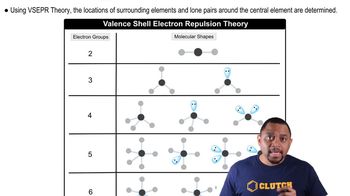 McMurry 8th Edition
McMurry 8th Edition Ch.8 - Covalent Compounds: Bonding Theories and Molecular Structure
Ch.8 - Covalent Compounds: Bonding Theories and Molecular Structure Problem 32
Problem 32The following ball-and-stick molecular model is a representation
of acetaminophen, the active ingredient in such over-thecounter
headache remedies as Tylenol. 1Red = O, gray = C,
blue = N, ivory = H.2
(c) What is the geometry around each carbon?

 Verified step by step guidance
Verified step by step guidance
Verified Solution
Key Concepts
Molecular Geometry

VSEPR Theory

Hybridization

Three of the following molecular models have a tetrahedral central atom, and one does not. Which is the odd one? (There may be a 'hidden' atom directly behind a visible atom in some cases.) (a)
(b)
(c)
(d)
The following ball-and-stick molecular model is a representation of acetaminophen, the active ingredient in such over-thecounter headache remedies as Tylenol. (Red = O, gray = C, blue = N, ivory = H.) (a) What is the formula of acetaminophen?
The following ball-and-stick molecular model is a representation of acetaminophen, the active ingredient in such over-thecounter headache remedies as Tylenol. (Red = O, gray = C, blue = N, ivory = H.) (b) Indicate the positions of the multiple bonds in acetaminophen.
The following ball-and-stick molecular model is a representation of thalidomide, a drug that causes birth defects when taken by expectant mothers but is valuable for its use against leprosy. The lines indicate only the connections between atoms, not whether the bonds are single, double, or triple. 1Red = O, gray = C, blue = N, ivory = H.2 (a) What is the formula of thalidomide?